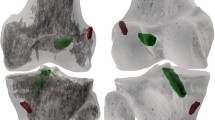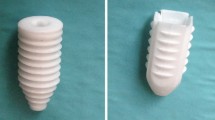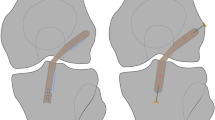Abstract
Purpose
The purpose of this study was to evaluate the effect of bioabsorbable interference screw diameter on the pullout strength and failure mode for femoral tunnel fixation in primary anterior cruciate ligament reconstruction (ACLR) at time zero fixation using bone-patellar tendon-bone (BTB) autograft in a cadaveric model.
Methods
Twenty-four fresh-frozen cadaveric knees were obtained from 17 different donors. Specimens were allocated to three different treatment groups (n = 8 per group) based on interference screw diameter: 6 mm, 7 mm, or 8 mm biocomposite interference screw. All specimens underwent dual energy X-ray absorptiometry (DEXA) scanning prior to allocation to ensure no difference in bone mineral density among groups (n.s.). All specimens underwent femoral-sided ACLR with BTB autograft. Specimens subsequently underwent mechanical testing under monotonic loading conditions to failure. The load to failure and failure mechanism were recorded.
Results
The mean pullout force (N) at time zero for each group was 309 ± 213 N, 518 ± 313 N, and 541 ± 267 N for 6 mm, 7 mm, and 8 mm biocomposite interference screw diameter, respectively (n.s.). One specimen in the 6 mm group, two specimens in the 7 mm group, and one specimen in the 8 mm group failed by screw pullout. The remainder in each group failed by graft failure (n.s.).
Conclusion
Biocomposite interference screw diameter did not have a significant influence on fixation pullout strength or failure mode following femoral tunnel fixation using BTB autograft at time zero. A 6 mm interference screw can improve preservation of native bone stock, increase potential for biologic healing, and decrease the risk of damage to the graft during insertion without significantly compromising fixation strength. This study supports the use of smaller 6 mm interference screw diameter options for femoral tunnel fixation in ACLR.

Similar content being viewed by others
Availability of Data and Materials
The data generated during and/or analyzed during the current study are available from the corresponding author upon reasonable request.
References
Su CA, Knapik DM, Trivedi NN, Megerian MF, Salata MJ, Voos JE (2020) Femoral interference screw fixation in ACL reconstruction using bone-patellar tendon-bone grafts. JBJS Rev 8(1):e0066
Dai W, Leng X, Wang J, Cheng J, Hu X, Ao Y (2022) Quadriceps tendon autograft versus bone-patellar tendon–bone and hamstring tendon autografts for anterior cruciate ligament reconstruction: a systematic review and meta-analysis. Am J Sports Med 50(12):3425–3439
Salmon LJ, Russell VJ, Refshauge K, Kader D, Connolly C, Linklater J, Pinczewski LA (2006) Long-term outcome of endoscopic anterior cruciate ligament reconstruction with patellar tendon autograft: minimum 13-year review. Am J Sports Med 34(5):721–732
Samuelsen BT, Webster KE, Johnson NR, Hewett TE, Krych AJ (2017) Hamstring autograft versus patellar tendon autograft for ACL reconstruction: is there a difference in graft failure rate? A meta-analysis of 47,613 patients. Clin Orthop Relat Res 475(10):2459–2468
Kruse LM, Gray B, Wright RW (2012) Rehabilitation after anterior cruciate ligament reconstruction. J Bone Joint Surg Am 94(19):1737–1748
Piedade SR, Leite Arruda BP, Antunes de Vasconcelos R, Parker DA, Maffulli N (2022) Rehabilitation and advances in surgical reconstruction for anterior cruciate ligament insufficiency: what has changed since the 1960s? State of the art. J ISAKOS S2059–7754(22):00094–00103
Carmichael JR, Cross MJ (2009) Why bone–patella tendon–bone grafts should still be considered the gold standard for anterior cruciate ligament reconstruction. Br J Sports Med 43(5):323–325
Hurley ET, Calvo-Gurry M, Withers D, Farrington SK, Moran R, Moran CJ (2018) Quadriceps tendon autograft in anterior cruciate ligament reconstruction: a systematic review. Arthroscopy 34(5):1690–1698
MOON Knee Group, Spindler KP, Huston LJ, Zajichek A, Reinke EK, Amendola A, Andrish JT, Brophy RH, Dunn WR, Flanigan DC, Jones MH, Kaeding CC, Marx RG, Matava MJ, McCarty EC, Parker RD, Vidal AF, Wolcott ML, Wolf BR, Wright RW (2020) Anterior cruciate ligament reconstruction in high school and college-aged athletes: does autograft choice influence anterior cruciate ligament revision rates? Am J Sports Med 48(2):298–309
Noyes FR, Butler DL, Grood ES, Zernicke RF, Hefzy MS (1984) Biomechanical analysis of human ligament grafts used in knee-ligament repairs and reconstructions. J Bone Joint Surg Am 66(3):344–352
Salem HS, Varzhapetyan V, Patel N, Dodson CC, Tjoumakaris FP, Freedman KB (2019) Anterior cruciate ligament reconstruction in young female athletes: patellar versus hamstring tendon autografts. Am J Sports Med 47(9):2086–2092
Lubowitz JH, Schwartzberg R, Smith P (2015) Cortical suspensory button versus aperture interference screw fixation for knee anterior cruciate ligament soft-tissue allograft: a prospective. Randomized Controlled Trial Arthroscopy 31(9):1733–1739
Saccomanno MF, Shin JJ, Mascarenhas R, Haro M, Verma NN, Cole BJ, Bach BR (2014) Clinical and functional outcomes after anterior cruciate ligament reconstruction using cortical button fixation versus transfemoral suspensory fixation: a systematic review of randomized controlled trials. Arthrscopy 30(11):1491–1498
Vaidya R, Roth M, Nanavati D, Prince M, Sethi A (2015) Low-velocity knee dislocations in obese and morbidly obese patients. Orthop J Sports Med 3(4):2325967115575719
Frosch S, Rittstieg A, Balcarek P, Walde TA, Schüttrumpf JP, Wachowski MM, Stürmer KM, Frosch K-H (2012) Bioabsorbable interference screw versus bioabsorbable cross pins: influence of femoral graft fixation on the clinical outcome after ACL reconstruction. Knee Surg Sports Traumatol Arthrosc 20(11):2251–2256
Lambert KL (1983) Vascularized patellar tendon graft with rigid internal fixation for anterior cruciate ligament insufficiency. Clin Orthop Relat Res 172:85–89
Brown CH, Hecker AT, Hipp JA, Myers ER, Hayes WC (1993) The biomechanics of interference screw fixation of patellar tendon anterior cruciate ligament grafts. Am J Sports Med 21(6):880–886
Butler JC, Branch TP, Hutton WC (1994) Optimal graft fixation—the effect of gap size and screw size on bone plug fixation in ACL reconstruction. Arthroscopy 10(5):524–529
Eichinger M, Schmoelz W, Attal R, Moroder A, Heinrichs CH, Smekal V, Mayr R (2018) Screw oversizing for anterior cruciate ligament graft fixation in primary and enlarged tibial tunnels: a biomechanical study in a porcine model. Knee 25(5):774–781
Ezechieli M, Ettinger M, König C, Weizbauer A, Helmecke P, Schavan R, Lucas A, Windhagen H, Becher C (2016) Biomechanical characteristics of bioabsorbable magnesium-based (MgYREZr-alloy) interference screws with different threads. Knee Surg Sports Traumatol Arthrosc 24(12):3976–3981
Shapiro JD, Jackson DW, Aberman HM, Lee TQ, Simon TM (1995) Comparison of pullout strength for seven- and nine-millimeter diameter interference screw size as used in anterior cruciate ligament reconstruction. Arthroscopy 11(5):596–599
Weiler A, Hoffmann RFG, Siepe CJ, Kolbeck SF, Südkamp NP (2000) The influence of screw geometry on hamstring tendon interference fit fixation. Am J Sports Med 28(3):356–359
Micucci CJ, Frank DA, Kompel J, Muffly M, DeMeo PJ, Altman GT (2010) The effect of interference screw diameter on fixation of soft-tissue grafts in anterior cruciate ligament reconstruction. Arthroscopy 26(8):1105–1110
Kohn D, Rose C (1994) Primary stability of interference screw fixation: influence of screw diameter and insertion torque. Am J Sports Med 22(3):334–338
Brown GA, Peña F, Grøntvedt T, Labadie D, Engebretsen L (1996) Fixation strength of interference screw fixation in bovine, young human, and elderly human cadaver knees: influence of insertion torque, tunnel-bone block gap, and interference. Knee Surg Sports Traumatol Arthrosc 3(4):238–244
Mitchell JJ, Dean CS, Chahla J, Menge TJ, Cram TR, LaPrade RF (2016) Posterior wall blowout in anterior cruciate ligament reconstruction. Orthop J Sports Med 4(6):2325967116652122
Palazzolo A, Rosso F, Bonasia DE, Saccia F, Rossi R (2018) Uncommon complications after anterior cruciate ligament reconstruction. Joints 6(3):188–203
Rue J-PH, Busam ML, Detterline AJ, Bach BR (2008) Posterior wall blowout in anterior cruciate ligament reconstruction: avoidance, recognition, and salvage. J Knee Surg 21(3):235–240
Markolf K, Gorek J, Kabo M, Shapiro M (1990) Direct measurement of resultant forces in the anterior cruciate ligament. An in vitro study performed with a new experimental technique. J Bone Joint Surg Am 72(4):557–567
Domnick C, Raschke MJ, Herbort M (2016) Biomechanics of the anterior cruciate ligament: physiology, rupture and reconstruction techniques. World J Orthop 7(2):82–93
Freudmann M, Bollen S (2011) The demographics of ACL injury over a twelve year period: is skiing to blame for the changes? Orthop Proc 93-B:13–13
Liukkonen RJ, Ponkilainen VT, Reito A (2022) Revision rates after primary ACL reconstruction performed between 1969 and 2018: a systematic review and metaregression analysis. Orthop J Sports Med 10(8):23259671221110190
Moretti L, Bizzoca D, Cassano GD, Caringella N, Delmedico M, Moretti B (2022) Graft intra-articular remodeling and bone incorporation in ACL reconstruction: the state of the art and clinical implications. J Clin Med 11(22):6704. https://doi.org/10.3390/jcm11226704
Arama Y, Salmon LJ, Sri-Ram K, Linklater J, Roe JP, Pinczewski LA (2015) Bioabsorbable versus titanium screws in anterior cruciate ligament reconstruction using hamstring autograft: a prospective, blinded, randomized controlled trial with 5-year follow-up. Am J Sports Med 43(8):1893–1901
Barber FA, Dockery WD (2020) Biocomposite interference screws in anterior cruciate ligament reconstruction: osteoconductivity and degradation. Arthroscopy 2:e53
Acknowledgements
We would like to acknowledge Jay Bensusan, MS for his contribution to the mechanical testing and technical assistance throughout this study. We would also like to thank Arthrex, Inc (Naples FL) for providing grant funding (Grant US-19069) to assist with the completion of this study.
Funding
Arthrex, Inc. Grant US-19069.
Author information
Authors and Affiliations
Contributions
JI participated in conception of the study and study design, participated in surgeries, analyzed the data, performed statistical analysis, and drafted the manuscript. MM participated with the surgeries, analyzed the data, and assisted with drafting the manuscript. DK participated in conception of the study and study design and assisted with editing of the manuscript. JC participated with the surgeries and assisted with editing the manuscript, CR participated in conception of the study and study design, participated in the mechanical testing, and assisted with editing of the manuscript. JV participated in conception of the study and study design, performed the surgeries, and assisted with editing of the manuscript. All authors read and approved the final manuscript.
Corresponding author
Ethics declarations
Conflict of interest
Jason Ina received a grant from Arthrex, Inc related to the submitted work. He also received education support from Rock Medical outside of the submitted work. Mark Megerian declares that they have no competing interest. Derrick Knapik received a grant from Arthrex, Inc related to the submitted work. He also received education support from Smith and Nephew and Medwest Associates, outside of the submitted work. Jacob Calcei declares that they have no competing interest. Clare Rimnac is a senior associate editor for Clinical Orthopaedics and Related Research. She also received a research grant and donor tissue from the Musculoskeletal Transplant Foundation, outside of the submitted work. James Voos received a grant from Arthrex, Inc related to the submitted work. He also is a consultant for Arthrex, outside of the submitted work.
Ethical approval
IRB exemption was obtained for the completion of this study.
Informed consent
No informed consent was required for the completion of this study.
Social media handles
*Instagram @uhortho, @drcalcei.
Additional information
Publisher's Note
Springer Nature remains neutral with regard to jurisdictional claims in published maps and institutional affiliations.
Supplementary Information
Below is the link to the electronic supplementary material.
Supplementary file2 (MP4 4358 KB)
Supplementary file3 (MP4 12161 KB)
Rights and permissions
Springer Nature or its licensor (e.g. a society or other partner) holds exclusive rights to this article under a publishing agreement with the author(s) or other rightsholder(s); author self-archiving of the accepted manuscript version of this article is solely governed by the terms of such publishing agreement and applicable law.
About this article
Cite this article
Ina, J.G., Megerian, M.F., Knapik, D.M. et al. Smaller diameter femoral tunnel biocomposite interference screws provide adequate fixation strength in anterior cruciate ligament reconstruction. Knee Surg Sports Traumatol Arthrosc 31, 3434–3440 (2023). https://doi.org/10.1007/s00167-023-07421-z
Received:
Accepted:
Published:
Issue Date:
DOI: https://doi.org/10.1007/s00167-023-07421-z




